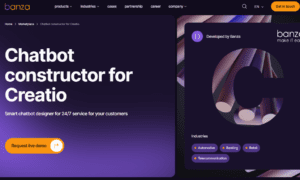Embrace the horizon of customer interaction ahead! In today’s dynamic realm, where communication transcends borders, it’s imperative for enterprises to dismantle language barriers and foster seamless connections with customers. Enter multilingual chatbots a groundbreaking solution. These innovative virtual aides have redefined how businesses engage with their global clientele, ensuring tailor-made experiences irrespective of language preferences.
Introduction
Unveiling Seamless Customer Interaction
In the pursuit of delivering seamless customer interaction, businesses must communicate in the language native to their customers. This is where chatbots play a pivotal role. These software applications emulate human conversations, designed to comprehend user inputs and respond in natural language.
Multilingual chatbots are those equipped to converse in multiple languages. This proficiency benefits businesses by enabling outreach to diverse audiences.
Moreover, it allows for the offering of assistance in various languages, accommodating individuals who might not feel at ease with communicating in English.
Multilingual chatbots fulfill a range of roles, such as providing customer support, resolving inquiries, and facilitating informal discussions. Regardless of their particular function, they elevate the customer experience by enabling interaction in the language preferred by the customer.
Ultimately, seamless customer interaction entails crafting an experience that feels intuitive and organic. Leveraging the prowess of multilingual chatbots empowers businesses to provide personalized and engaging experiences to customers.
The Advantages of Multilingual Chatbots
In an increasingly interconnected world, businesses aspire to transcend language barriers and cater to their international customer base. One approach is integrating multilingual chatbots into the customer engagement strategy.
Chatbots, simulated conversational agents, can address customer queries, offer support, and even give recommendations. Propelled by artificial intelligence (AI), they continuously learn and enhance their performance.
Multilingual chatbots deliver manifold advantages for businesses. They extend market reach, broaden the customer base, and enhance customer satisfaction.
Expanding Market Reach: Chatbots obliterate language barriers, thereby broadening market reach. Customers across the globe can now interact in their native tongues, eliminating language-related impediments. This streamlined experience encourages business transactions, potentially amplifying sales and revenue.
Diversifying the Customer Base: Multilingual chatbots not only facilitate entry into new markets but also cultivate relationships with customers who communicate in various languages. This inclusive approach could lead to heightened customer retention and augmented customer lifetime value (CLV).
Augmenting Customer Satisfaction: Chatbots bolster customer satisfaction through rapid, accurate responses. Infused with AI, they offer personalized interactions by learning individual preferences and histories. This expedites query resolution, heightening customer contentment.
Overall, multilingual chatbots empower businesses by expanding their reach and enriching customer satisfaction. For enterprises aiming to better serve international clients, integrating multilingual chatbots into the customer engagement strategy presents an astute choice.
Mechanics of Multilingual Chatbots
Powered by artificial intelligence and natural language processing, multilingual chatbots offer personalized experiences and expedite issue resolution.
Here’s the operational process:
- The chatbot comprehends the user’s intent.
- The chatbot responds in the user’s native language.
- The chatbot furnishes an accurate, tailored response.
- The chatbot expedites issue resolution by directing users to pertinent resources.
- The chatbot evolves through each interaction, refining its performance over time.
Designed for intuitiveness, efficiency, and assistance, multilingual chatbots catalyze customer satisfaction and accelerate service resolution.
Design Considerations for Multilingual Chatbots
Developing a multilingual chatbot mandates careful deliberation on multiple fronts Begin by considering the language inclinations of your intended audience. What languages are familiar to them? Which language do they lean towards when engaging with chatbots? Next, recognize the wide array of communication customs spanning various cultures. Do conversations tend to be more formal or casual? Are there any cultural subtleties that require attention? Lastly, guarantee that your chatbot’s interface remains easy to navigate regardless of varying levels of language expertise.
This necessitates thoughtful interface layout, judicious employment of icons and visuals, and an impeccable user experience. It’s imperative to ensure your chatbot comprehends and responds adeptly to the spectrum of languages it encounters, demanding meticulous design and testing of its natural language processing capabilities.
Exemplary Instances of Multilingual Chatbot Implementations
Successful multilingual chatbot implementations abound. A standout case is the chatbot developed by Meiya Pte Ltd, a Singapore-based provider of customer engagement solutions. This chatbot was engineered to facilitate multilingual customer interactions. It adeptly interacts with users in languages including English, Mandarin, Cantonese, and Japanese.
An additional example can be found in the chatbot created by Webpower, a Dutch company that specializes in solutions for customer engagement. This chatbot enables businesses to interact with customers in various languages including Dutch, English, French, German, Spanish, and Portuguese.
These instances merely scratch the surface of triumphant multilingual chatbot adoptions. Numerous companies have harnessed multilingual chatbots to foster interactions in diverse languages, nurturing stronger connections with their clientele.
Navigating Challenges in Multilingual Chatbot Integration
Creating chatbots that work in multiple languages comes with its own set of challenges. First, you need to decide which languages to include based on where your users are and what languages they speak. Then, setting up the technology to understand and respond correctly in each language can be tricky, especially if you’re not familiar with different systems.
Making sure the chatbot’s buttons and messages make sense in each language is really important. If not, the chatbot might not understand users or answer their questions well. Lastly, remember that different cultures use language differently. So, you have to adjust how the chatbot talks to fit each culture’s way of communicating.
Conclusion
The ascent of multilingual chatbot technology has ushered in an era of seamless customer interaction. Enterprises now transcend linguistic boundaries, engaging customers in their preferred languages for tailored, one-on-one communication. This amplifies satisfaction, curtails customer service costs, and streamlines global customer interactions. By harnessing this potent tool to engage an international clientele, businesses can optimize avenues for expansion and triumph.”

































